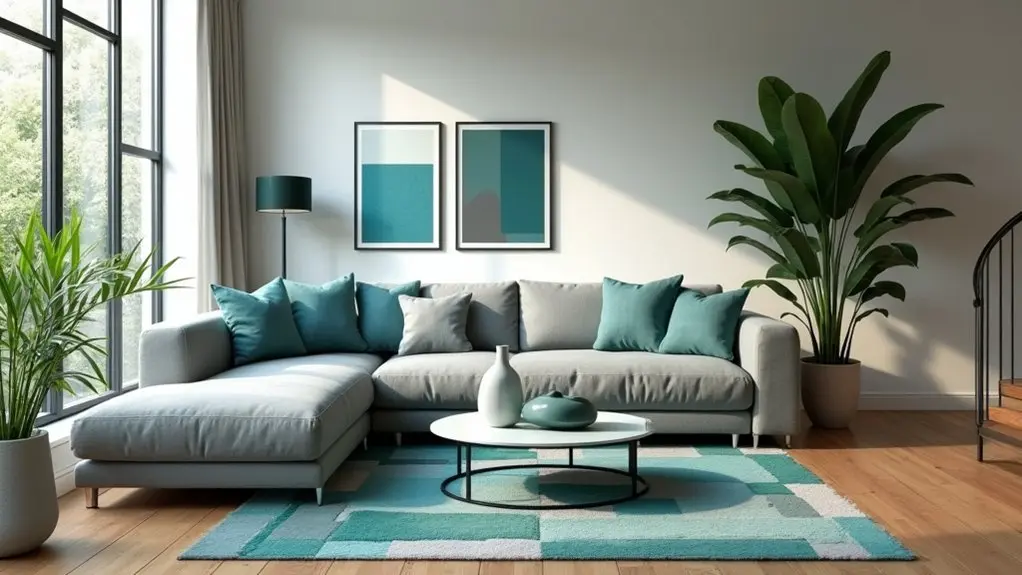
15 Gray and Teal Living Room Ideas That Feel Fresh and Chic
A gray and teal living room achieves a refined yet inviting aesthetic by layering soft gray walls with bold teal accents, such as statement sofas, feature walls, or textured textiles. Expertly mixing patterns, metallic accessories, and high-shine or natural wood surfaces brings depth and warmth. Strategic use of built-in storage maximizes function, while layered lighting and versatile rugs define zones. Selecting varied shades and finishes guarantees a cohesive, chic effect—discover further expert ideas and visual inspirations below.
Key Takeaways
- Pair soft gray walls with bold teal accent pieces or wallpaper for a balanced, modern statement.
- Use a gray sectional sofa with teal piping or pillows to anchor the space and add visual interest.
- Incorporate layered rugs and mixed textiles in teal and gray to build depth and comfort.
- Add metallic decor and natural wood accents for sophisticated contrast and warmth.
- Experiment with pops of mustard or coral accessories to energize the gray and teal palette.
Pair a Teal Sofa With Soft Gray Walls
A teal sofa set against soft gray walls establishes a striking focal point, infusing the living room with both vibrancy and warmth while preserving an elegant, understated atmosphere. The juxtaposition of the teal sofa’s rich hue with the soft gray walls’ neutral undertones creates immediate visual interest, anchoring the room in a modern aesthetic. This sophisticated palette allows for effortless integration of diverse decor styles, from contemporary to transitional. Designers recommend layering soft textiles—such as throw pillows and blankets—in complementary shades of teal and gray to enhance comfort and reinforce the color story. The soft gray walls serve as a subtle backdrop, accentuating the depth of the teal sofa without overpowering the space, achieving balance and cohesion for an inviting, visually compelling living area. Layered lighting improves ambiance and functionality, incorporating a mix of overhead, task, and accent lighting to further enhance the room’s aesthetic appeal.
Ground the Room With a Gray Sectional and Teal Accessories
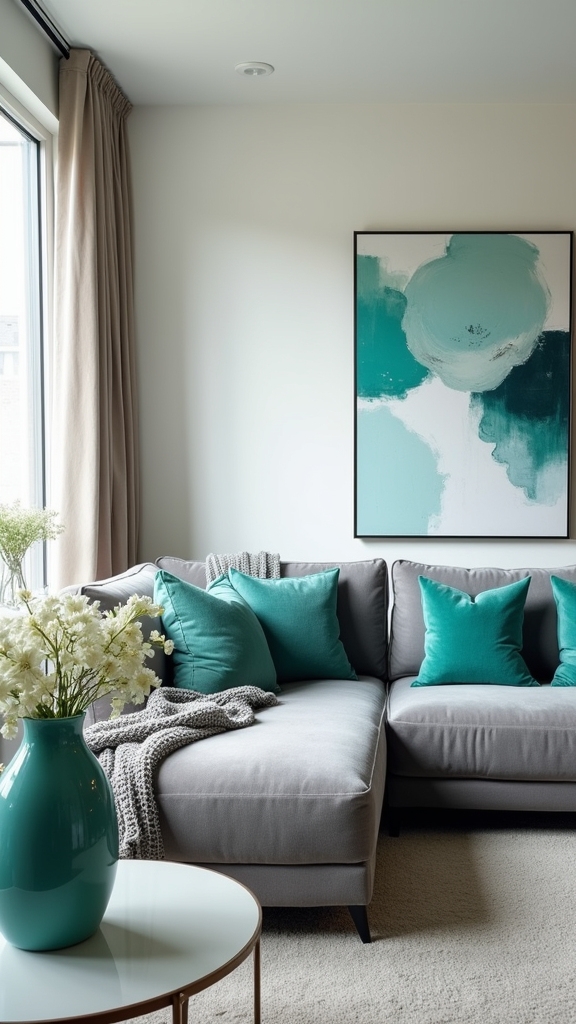
A gray sectional establishes a neutral anchor for the living room, inviting dynamic layering through textured teal throws and accent pillows. Incorporating teal artwork above or near the sectional introduces a compelling visual focal point, amplifying the color story. This strategic combination guarantees adaptability while maintaining a cohesive and sophisticated palette. Adding indoor plants can introduce freshness and vibrancy, further enhancing the aesthetic appeal of the space.
Layer Textured Teal Throws
When layered thoughtfully over a gray sectional, textured teal throws introduce both tactile warmth and a vibrant color accent, instantly elevating the living room’s visual appeal.
Utilizing layered textured teal throws not only grounds the neutral backdrop of a gray sectional but also enhances the space’s color palette with dynamic visual interest. Selecting throws in varied materials—such as chunky knits or plush velvets—creates nuanced depth and dimension, making the seating area appear more inviting and sophisticated.
To maintain cohesion, integrating additional teal accessories, like small decorative objects or framed prints, guarantees a harmonious balance without overwhelming the design. Opting for a spectrum of teal shades within these accessories further refines the composition, resulting in a chic, contemporary living room that feels both fresh and well-curated.
Add Teal Accent Pillows
Building on the tactile intrigue introduced by textured teal throws, incorporating teal accent pillows onto a gray sectional further anchors the living room’s palette while amplifying both comfort and style. Expertly selected teal accent pillows in a range of fabrics—such as velvet for sheen or cotton for breathability—contribute depth and dimension to the seating area. Mixing solid and patterned designs generates visual interest without disrupting the cohesive look. To maximize impact, coordinate pillow hues with other teal elements throughout the space. This approach guarantees the gray sectional remains a grounding centerpiece while the teal accents energize the room. Below is a quick guide for styling teal accent pillows:
| Pillow Type | Effect Achieved |
|---|---|
| Velvet Solid | Luxurious depth |
| Cotton Patterned | Playful visual interest |
| Embroidered | Artistic dimension |
| Knit Textures | Cozy, tactile appeal |
| Ombre | Subtle color gradient |
Highlight With Teal Art
While a gray sectional establishes a versatile and contemporary foundation, the strategic introduction of teal art instantly improves the living room’s visual impact.
Teal art, whether in the form of abstract canvases or textured wall hangings, transforms the wall into a dynamic focal point, balancing the neutrality of gray furniture with vibrant color. This approach raises the design’s sophistication without overwhelming the senses.
Best results are achieved through thoughtful layering and material choices:
- Select bold teal art to serve as a primary focal point above the sectional.
- Integrate teal throw pillows and blankets for cohesive accentuation of the seating.
- Use a blue and gray area rug to visually ground the space and unify color elements.
- Employ metallic frames—gold or silver—to add refined contrast.
- Guarantee balanced distribution of teal accessories throughout the room.
Make an Impact With a Teal Feature Wall
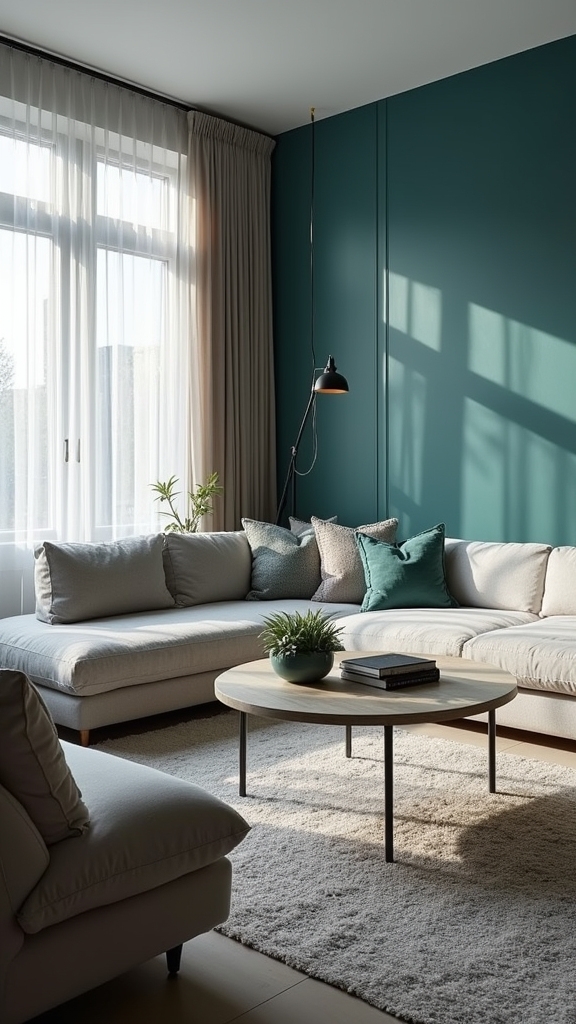
Selecting the ideal shade of teal is essential, as subtle undertones can influence the room’s ambiance and compatibility with existing gray elements. When styling around a teal feature wall, curating a balance of muted textiles and metallic accents enhances visual harmony and accentuates the wall’s impact. Incorporating layered lighting and strategic placement of art can further raise the space, ensuring the feature wall remains the room’s focal point. Consider adding bold pops of color like hot pink or yellow to create striking contrast and energize the monochromatic scheme.
Choosing the Right Shade
A teal feature wall introduces a dynamic focal point in the living room, infusing the space with depth and visual intrigue that pairs effortlessly with grey furnishings.
Selecting the ideal shade is essential for achieving the desired atmosphere. Deeper teal tones deliver a bold, dramatic statement, while lighter shades evoke an airy, tranquil mood.
Precision in color selection guarantees harmony with existing grey decor and enhances the interplay of light within the room. Expert guidance recommends considering undertones, light exposure, and textural balance.
- Deep teal shades create a moody, sophisticated backdrop for grey decor.
- Lighter teal hues promote a serene, expansive effect.
- Incorporate soft textures in teal to temper the vibrancy of the accent wall.
- Use neutral accessories to maintain visual cohesion.
- Examine paint samples in various lighting conditions before finalizing.
Styling Around Teal Walls
With the ideal shade of teal chosen, attention shifts to styling techniques that maximize the wall’s impact.
Teal walls, when paired with grey furniture, create a cozy yet sophisticated living space by balancing boldness with neutrality. To further enhance visual interest, introduce artwork or decorative accessories in varying shades of teal, blue, or contrasting hues.
Metallic finishes or strategically placed mirrors amplify light, making the room appear brighter and more dynamic. For a serene atmosphere, opt for lighter teal tones, while deeper shades introduce drama and depth.
Layering textures—such as plush throws or velvet cushions—on grey seating softens the overall aesthetic. The interplay of these elements guarantees that a teal feature wall becomes a compelling focal point without overwhelming the space.
Layer Gray and Teal Textiles for Cozy Depth
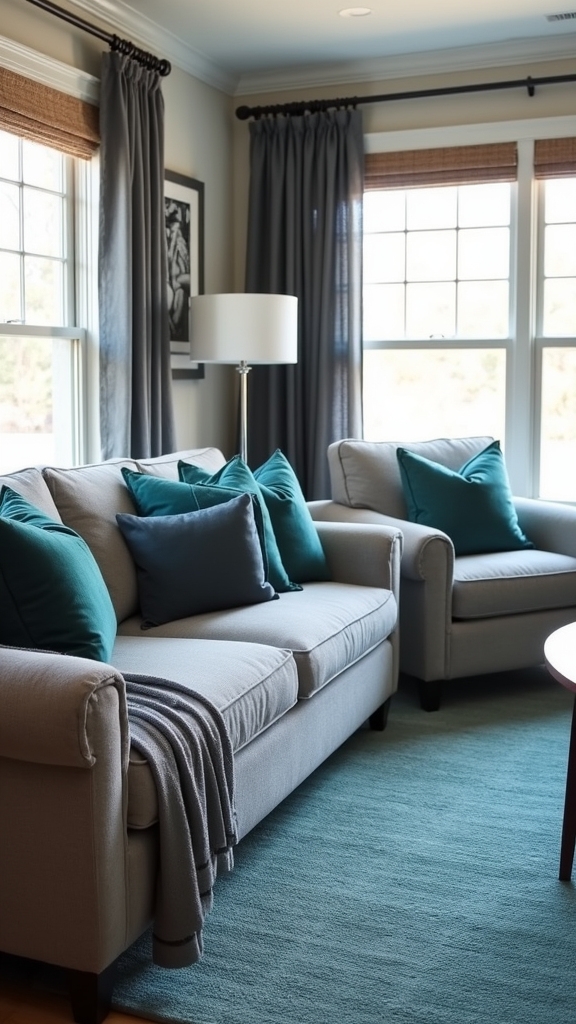
Layering textiles in complementary shades of gray and teal introduces both visual depth and tactile comfort to a living room. This approach employs a refined mix of fabrics and patterns, enhancing the sense of coziness while reinforcing the color palette.
Expertly combining materials such as velvet, cotton, and faux fur creates a balanced interplay between softness and visual intrigue. To achieve ideal depth and warmth, consider the following strategies:
- Place a plush teal area rug beneath a gray sofa to anchor and warm the seating zone.
- Mix patterned textiles—striped or floral cushions in teal and gray—for dynamic contrast.
- Drape a chunky knit blanket over a gray armchair for tactile appeal.
- Combine velvet cushions with knitted throws to enrich the layered effect.
- Use varying fabric weights to build dimension and invite relaxation.
- Incorporate bold colors as accents through throw pillows or accent walls to add vibrancy and complement the overall design aesthetic.
Add Drama With Bold Teal Wallpaper

Bold teal wallpaper instantly commands attention, especially when selected in eye-catching patterns such as geometrics or florals.
To prevent visual overwhelm, designers recommend balancing the statement wall with neutral gray furnishings and minimalist decor.
This approach maintains harmony in the space while allowing the teal feature to serve as a sophisticated focal point.
Choose Striking Pattern Designs
A striking pattern design in teal wallpaper can enhance a gray and teal living room, establishing an immediate focal point that infuses the space with energy and depth.
Expertly chosen striking pattern designs—such as bold geometrics or modern florals—introduce visual interest and sophistication when paired with neutral gray elements.
Utilizing teal wallpaper for accent walls defines spatial boundaries and draws the eye, while textured or glossy finishes amplify light and create dimension.
For maximum impact, consider the following strategic applications:
- Select large-scale patterns for accent walls to anchor the room’s color scheme.
- Opt for teal wallpaper with a glossy finish to reflect ambient light.
- Integrate tactile, raised patterns for added depth.
- Pair with sleek gray furnishings for contemporary contrast.
- Use pattern repetition to unify the overall design narrative.
Balance Bold With Neutrals
Frequently, designers employ bold teal wallpaper as a visual anchor in gray and teal living rooms, utilizing its deep saturation to introduce drama and contrast.
The interplay between a rich teal wall covering and neutral grey furnishings establishes a harmonious balance, elevating the overall composition without sacrificing tranquility.
Selecting wallpaper with subtle patterns or textural elements further enhances depth, ensuring the teal remains sophisticated rather than overwhelming.
To create cohesion, thoughtfully incorporate teal accents—such as throw pillows, vases, or artwork—which echo the wallpaper’s hue and unify the space.
Grey sofas and rugs serve as grounding elements, tempering the vibrancy of teal with understated elegance.
This strategic approach results in a living room that feels simultaneously lively, chic, and visually cohesive.
Incorporate Metallic Accents for Modern Flair
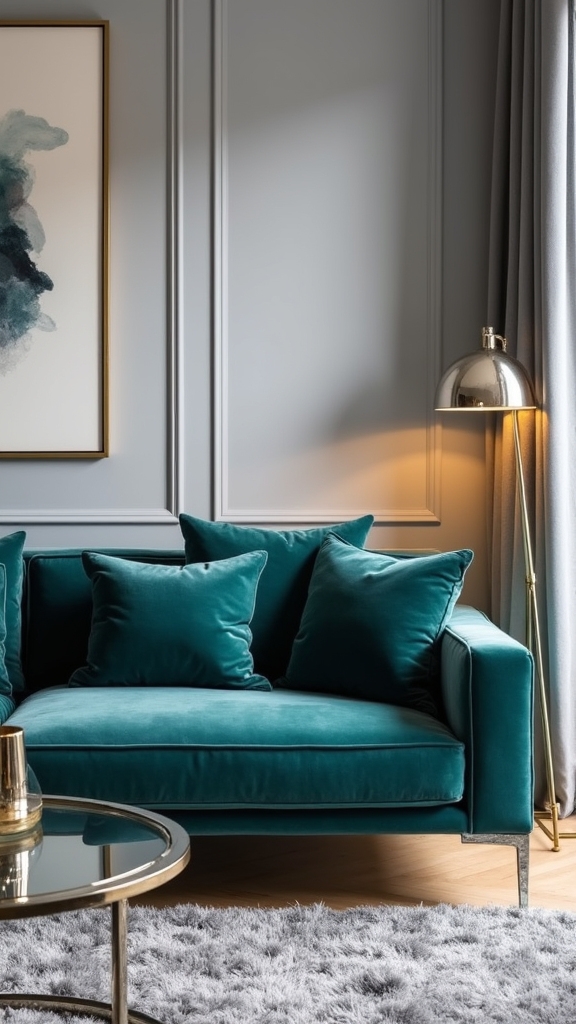
Raise a gray and teal living room by strategically introducing metallic accents to infuse modern sophistication and visual intrigue.
Metallic elements serve as dynamic highlights, reflecting light and accentuating the cool undertones of gray and teal living spaces. For a chic and contemporary atmosphere, focus on selective placements and finishes that offer a modern touch without overwhelming the design.
- Opt for metallic picture frames or vases in gold or silver to subtly enhance shelves or mantels.
- Integrate statement metallic light fixtures, like pendant lights or sculptural floor lamps, as striking focal points.
- Choose a coffee table with a sleek metal base to create contrast against plush textiles.
- Layer metallic accent tables or trays to introduce dimensionality.
- Add throw pillows with metallic threads for a refined, cohesive finish.
Incorporating floating shelves can provide sleek display options that enhance the modern aesthetic while saving precious floor space.
Create Balance With Teal Artwork and Gray Furnishings
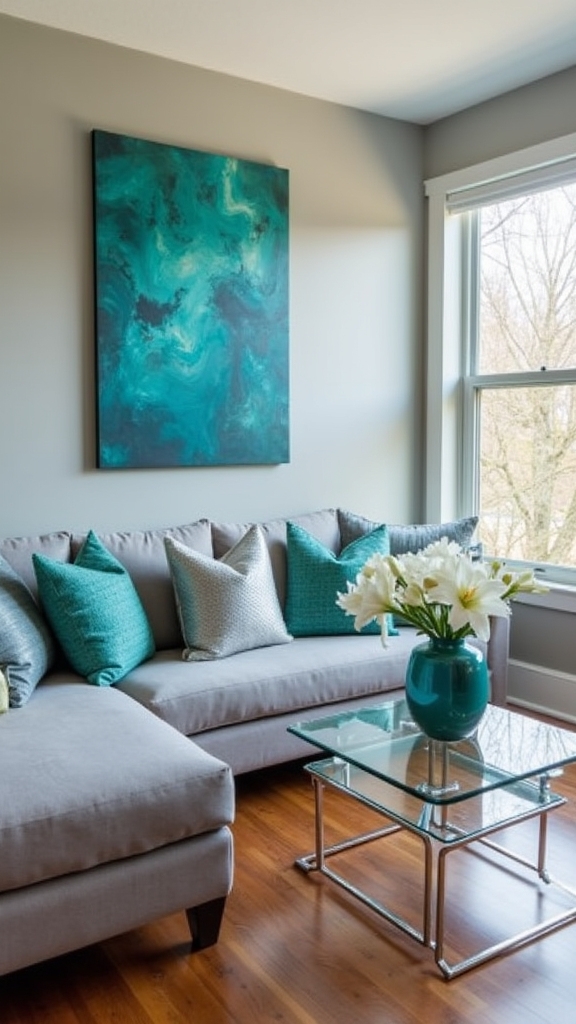
While gray furnishings provide a versatile and sophisticated foundation, introducing teal artwork establishes a vibrant focal point and enhances the visual dynamics of the living room.
Selecting artwork that incorporates both teal and gray hues guarantees cohesion within the overall color scheme, seamlessly connecting decor elements.
Large-scale teal paintings or prints can function as statement pieces, injecting depth and personality while offering a striking contrast to the neutral gray backdrop.
Expertly framed teal artwork with subtle gray accents adds visual interest and reinforces unity, preventing color competition.
For maximum impact, placing teal artwork at eye level or above gray furnishings raises the composition, drawing the eye and anchoring the room’s aesthetic.
Incorporating geometric patterns in textiles or artwork further enhances the modern appeal, creating a cohesive and stylish environment.
This strategic approach creates a harmonious, chic environment that feels both fresh and thoughtfully curated.
Mix Patterns in Shades of Gray and Teal
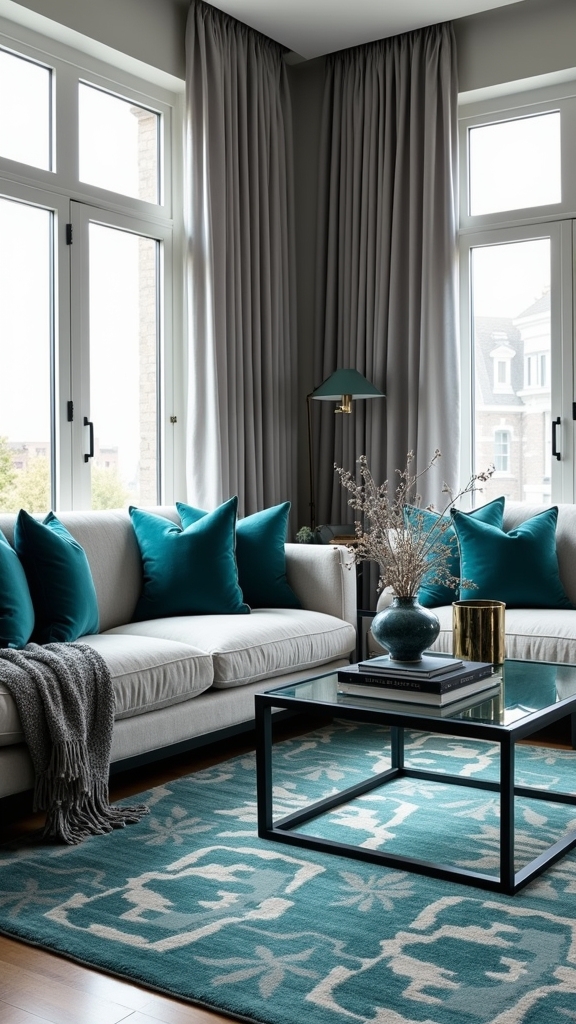
A thoughtful assortment of patterns in gray and teal introduces dynamic visual layers that enhance the living room’s design.
Strategic mixing of patterns—such as geometric, floral, and stripes—elevates visual interest while maintaining cohesion through a consistent color palette.
Expertly coordinated cushions, throws, and rugs in varying shades of gray and teal add texture, personality, and depth without overwhelming the space.
Select patterns sharing similar tones or motifs to guarantee a balanced, harmonious look.
For a bolder statement, a teal patterned accent wall paired with gray furnishings creates a sophisticated focal point.
Consider these practical applications:
- Combine geometric and floral textiles for contrast
- Layer a striped rug with solid or patterned cushions
- Maintain consistent gray and teal undertones
- Use a patterned accent wall for dramatic effect
- Pair patterned decor with neutral furniture
Incorporate layering brown tones and textures alongside gray and teal to create a multi-dimensional and visually engaging living room space.
Highlight Architectural Features With Teal Paint

Beyond the interplay of patterns, architectural features serve as powerful design elements in a gray and teal living room.
Using teal paint on elements such as molding, wainscoting, or built-in shelves can strategically highlight these architectural features, creating dynamic contrast against a grey backdrop. A teal accent wall instantly draws the eye, establishing a clear focal point within the space while preserving a sophisticated, cohesive palette.
For added depth, designers often employ varying shades of teal on different features, enhancing the room’s dimensionality and visual interest. In areas with ample natural light, teal’s intensity is amplified, contributing brightness and warmth. Incorporating soft textures like velvet and linen can further enhance the comfort and depth of the space.
Soften the Space With Blue-Green Rugs on Gray Flooring
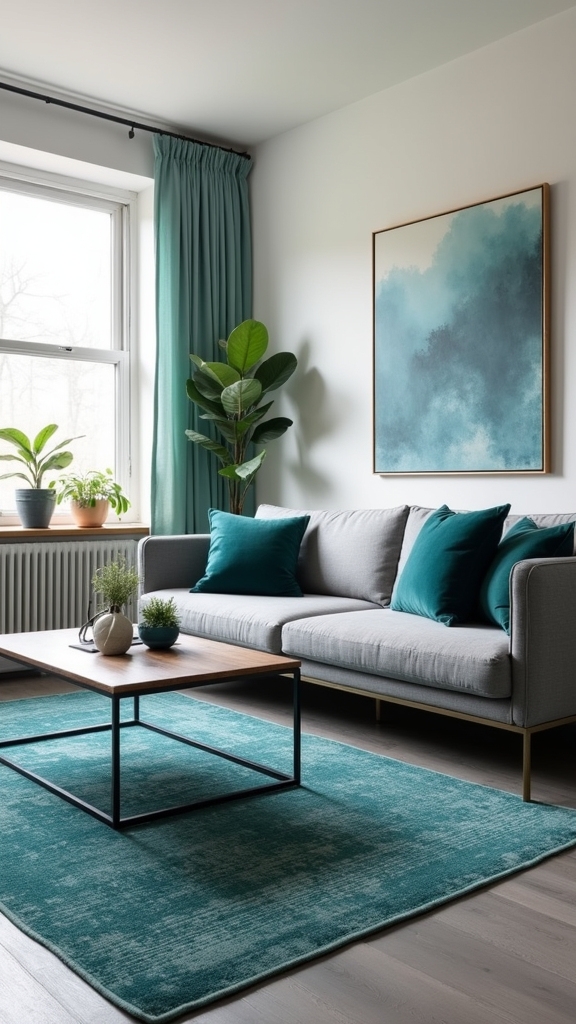
Introducing blue-green rugs atop gray flooring creates a sophisticated interplay of texture and color, effectively softening the living room’s overall ambiance.
Expert designers recommend layering textural area rugs to balance cool undertones and visually define functional zones within open-plan layouts.
Strategic rug placement not only anchors seating arrangements but also unifies disparate décor elements for a cohesive, inviting environment.
Incorporating plush throws can further enhance warmth and tactile allure, complementing the layered rugs to create a stylish and cozy living space.
Layer Textural Area Rugs
Frequently, layering textural area rugs in blue-green hues across gray flooring transforms a living room by infusing warmth and multidimensional depth. This approach not only softens the overall aesthetic but also amplifies tactile comfort underfoot.
Employing a teal area rug with subtle gray undertones establishes cohesion, while the interplay of different materials and pile heights enriches visual intrigue. For ideal execution, harmony between rug patterns and the existing color palette is essential.
Strategic rug placement helps delineate conversational zones and anchors furnishings within the space. Consider these expert recommendations:
- Select plush, textured area rugs to enhance softness and comfort.
- Combine teal and gray patterns for a unified color story.
- Layer a wool rug over a flat-weave for added dimension.
- Vary rug sizes to define functional zones.
- Prioritize visual balance with careful placement and layering.
Balance Cool Color Tones
A thoughtfully curated palette of cool color tones can enhance the ambiance of a gray living room, with blue-green rugs acting as visual bridges that soften stark flooring. Selecting blue-green rugs in varying shades of teal introduces depth and visual intrigue, counterbalancing the austerity of gray furniture and accents. This strategy creates a harmonious balance, ensuring the space feels both chic and welcoming. Opting for textured weaves or subtle patterns infuses warmth and tactile comfort, elevating the sensory appeal of the room. For those aiming to achieve a cohesive yet dynamic aesthetic, integrating blue-green rugs is a practical solution that unifies and refreshes the environment.
| Element | Visual Impact |
|---|---|
| Blue-green rugs | Adds depth and softens gray flooring |
| Gray furniture/accents | Grounds the palette, enhances harmony |
| Textured weaves | Introduces comfort and visual interest |
Define Zones With Rugs
Building on the impact of balanced cool tones, blue-green rugs on gray flooring serve as strategic anchors that establish distinct zones within a living room.
By utilizing area rugs in a gray and teal palette, designers create visual separation, delineating seating arrangements or transitional spaces in open-plan environments.
Selecting rugs with layered hues and texture further enhances spatial definition and comfort.
For ideal cohesion and interest, consider the following expert strategies:
- Use patterned area rugs that blend gray and teal to unify the room’s color scheme.
- Place rugs to define zones such as conversation areas or reading nooks.
- Opt for varying shades of blue-green to add visual depth.
- Select plush textures to soften hard gray floors and boost comfort.
- Choose rug sizes proportionate to each zone for a balanced layout.
Experiment With Mustard and Coral Accents
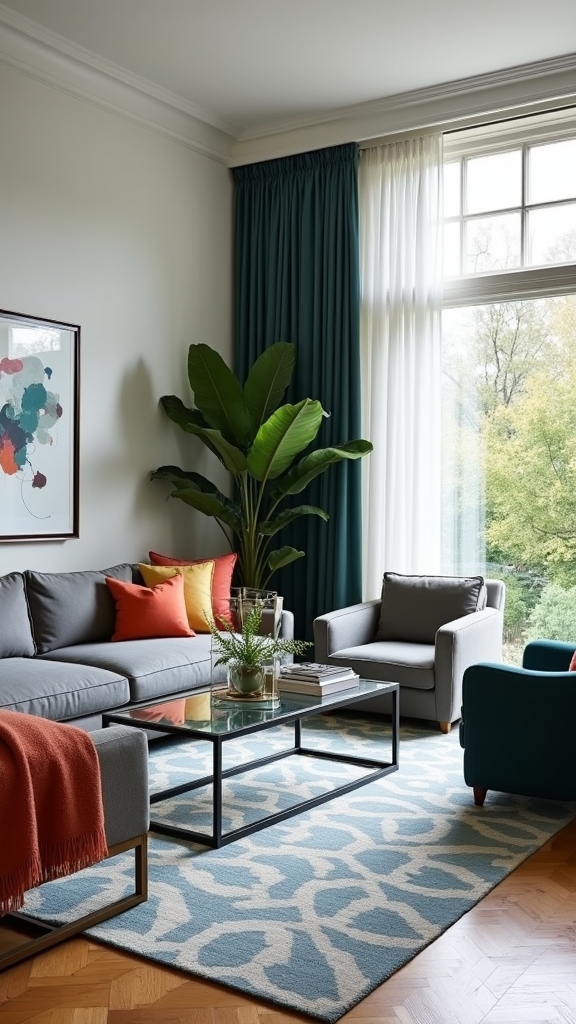
While gray and teal form a sophisticated foundation, introducing mustard and coral accents injects dynamic contrast and warmth into the living room.
Mustard accents, when applied through throws, vases, or cushions, offer a vibrant contrast that enlivens cooler undertones without overpowering the space. Coral accessories—such as pillows, artwork, or decorative objects—harmonize seamlessly with the existing palette, contributing playful energy and enhancing visual interest.
Mustard and coral accents enliven cool tones, adding vibrant contrast and playful energy while seamlessly enhancing your living room’s visual appeal.
For maximum effect, these bold hues should be used strategically: anchor the design with a statement chair in mustard or select a coral-toned art piece as a focal point. The interplay of mustard, coral, and teal establishes a dynamic color triangle, deepening the room’s aesthetic complexity while maintaining equilibrium. Incorporating warm color palette elements like mustard and coral ensures adaptability and ongoing visual appeal.
Use Light Gray for an Airy, Elegant Backdrop
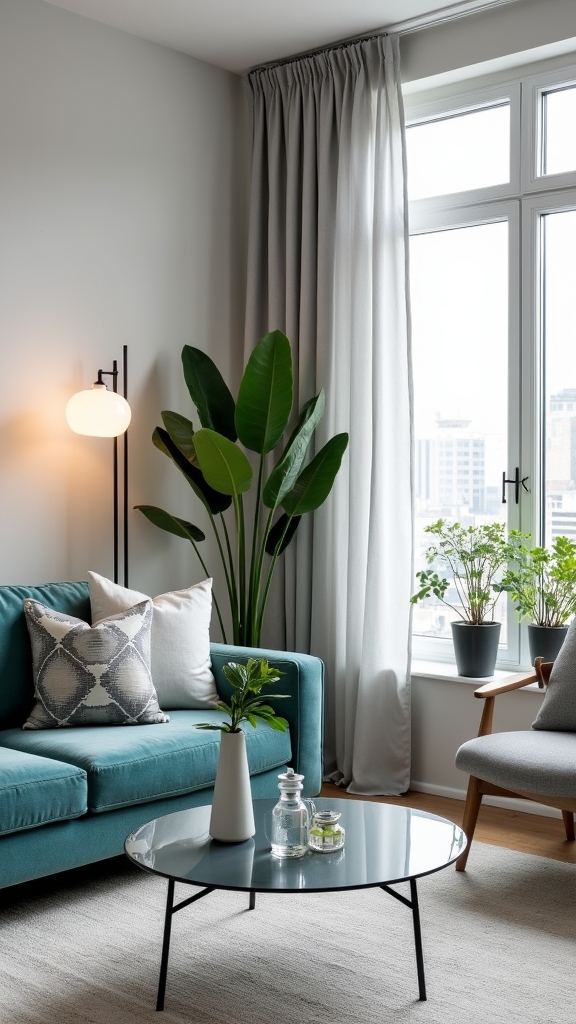
Light gray serves as an ideal foundation for a living room, imparting a sense of openness and understated elegance. This versatile hue establishes a serene, airy atmosphere that maximizes natural light and visually expands the space.
Light gray’s neutrality acts as a sophisticated canvas, allowing teal accents to become focal points without overwhelming the room. The interplay between these hues creates a balanced color scheme that suits both contemporary and classic interiors.
For best results, designers recommend strategic layering and thoughtful accessory selection:
- Select a matte or eggshell finish for light gray walls to diffuse light and reduce glare.
- Incorporate teal accents through textiles or art for dynamic contrast.
- Use streamlined furnishings to maintain visual flow.
- Choose minimalist window treatments to enhance brightness.
- Layer textures for depth without clutter.
Introduce Natural Wood Elements for Warmth
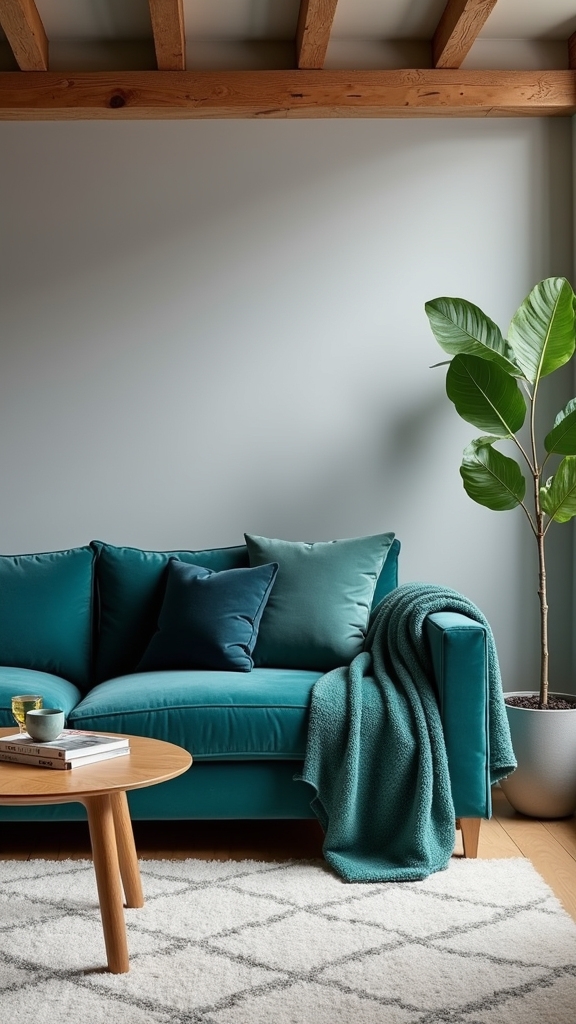
To further enhance the serene foundation established by light gray, integrating natural wood elements introduces much-needed warmth and tactile interest to a gray and teal living room.
Selecting a wooden coffee table in a light oak or maple finish allows natural light to reflect, amplifying the room’s brightness and keeping the palette fresh.
A light oak or maple coffee table brightens the space, reflecting natural light and preserving a crisp, inviting palette.
Reclaimed wood shelving or accent pieces add organic texture, creating a visually grounded and inviting atmosphere that contrasts effectively with cool gray and teal tones.
Wooden frames for artwork or mirrors can unify disparate design elements, maintaining a sophisticated continuity.
Layering these wood finishes with plush fabrics, such as cushions or throws, increases depth and comfort.
This expert approach guarantees the living space remains both warm and visually dynamic, without overwhelming the airy aesthetic.
Play With High-Shine Surfaces and Glass
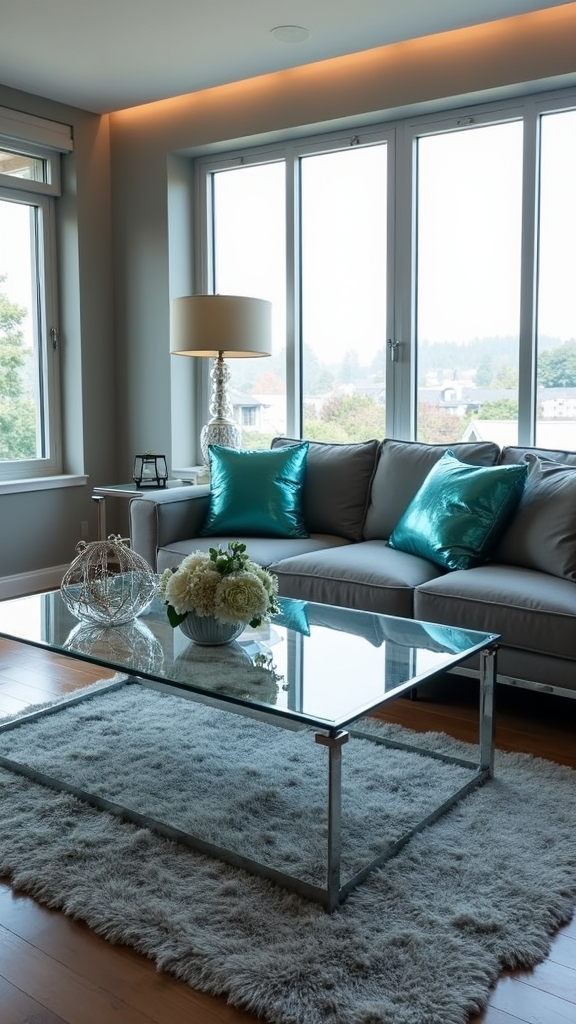
Enhance the sophistication of a gray and teal living room by integrating high-shine surfaces and glass accents.
These materials introduce a modern touch, amplifying natural light and imbuing the space with an airy, open ambiance. Expertly chosen glass elements—like a sleek coffee table or sculptural vases—maintain visual clarity, allowing the boldness of teal and the neutrality of gray to shine.
Meanwhile, reflective wall art and metallic finishes add dimension and highlight textural contrasts within the room. For practical and aesthetic refinement, consider the following:
- Select mirrored wall decor to reflect light and create spatial depth.
- Incorporate glass pendant lighting for a striking, contemporary focal point.
- Use metallic coffee tables or lamps for elegant high-shine surfaces.
- Opt for glass vases to introduce subtle transparency.
- Balance glossy finishes with plush gray textiles and teal cushions.
Maximize Small Spaces With Built-In Storage in Gray and Teal
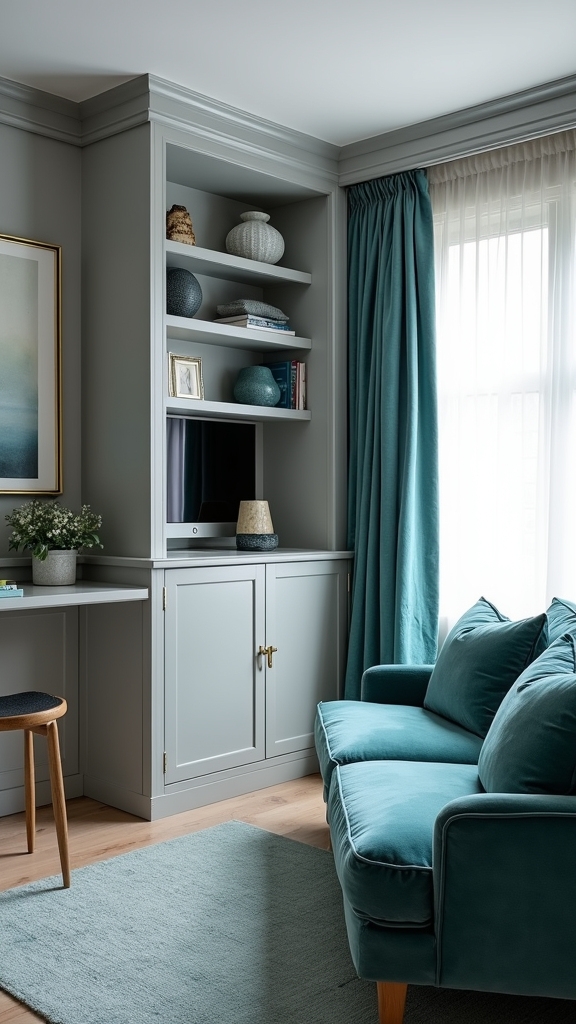
While reflective materials lend openness and elegance, optimizing limited square footage demands smart storage solutions seamlessly integrated into the gray and teal palette.
Built-in storage is essential for a small living room seeking a contemporary look without clutter. Floor-to-ceiling shelving in muted grey and teal tones utilizes vertical space, providing both display and concealed storage. A built-in buffet in teal, surrounded by grey paneling, offers a cohesive aesthetic while accommodating tableware or decorative accents.
Incorporating built-in seating with storage beneath, upholstered in grey fabric with teal piping, creates a multifunctional, space-saving nook. Multi-functional furniture, such as a grey sectional with hidden compartments, furthers organization.
Slatted wood walls with teal built-in shelves introduce warmth and texture, elevating the room’s practicality and visual harmony.
Frequently Asked Questions
Do Teal and Grey Go Together in a Living Room?
Teal accent walls paired with grey furniture styles create a balanced visual impact in living rooms. Strategic living room accessories and curated teal artwork choices further enhance cohesion, offering a sophisticated, contemporary palette with practical versatility and visual depth.
What Color Compliments Gray and Teal?
When selecting a color to complement gray accents and teal cushions, experts recommend incorporating neutral tones or vibrant artwork. Mustard yellow or deep navy introduce dynamic contrast, while crisp white or terracotta provide a grounded backdrop for cohesive visual interest.
How Do You Add Warmth to a Grey Living Room?
To add warmth to a grey living room, one utilizes cozy textiles, warm lighting, and natural elements such as wood and greenery. Strategically placed accent colors like ochre or rust further enhance visual interest and inviting ambiance.
What Color Goes With Teal in a Living Room?
When selecting colors to coordinate with teal accent pillows, teal wall art, teal area rugs, and teal furniture options, experts recommend pairing with warm neutrals, metallic finishes, or earthy tones to create balanced visual contrast and sophisticated depth.
Conclusion
A gray and teal living room offers a sophisticated palette that adapts to various design preferences, from subtle elegance to bold statements. By thoughtfully balancing these hues through textiles, feature walls, and statement furniture, homeowners can achieve both visual harmony and dynamic contrast. Incorporating natural textures, reflective surfaces, and practical storage further enhances the space’s functionality and appeal. Ultimately, this color combination delivers a fresh, contemporary atmosphere while providing ample flexibility for personal expression.
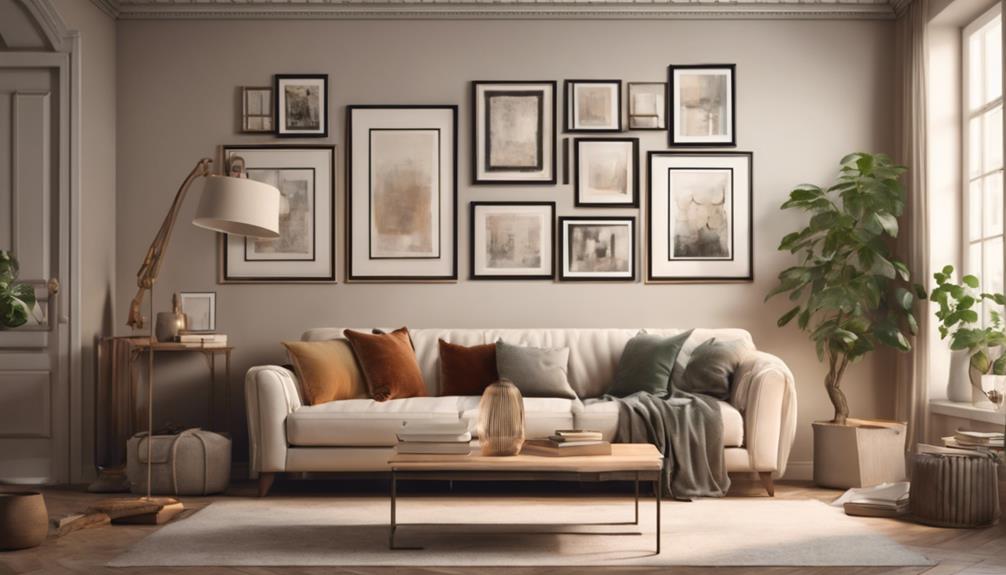
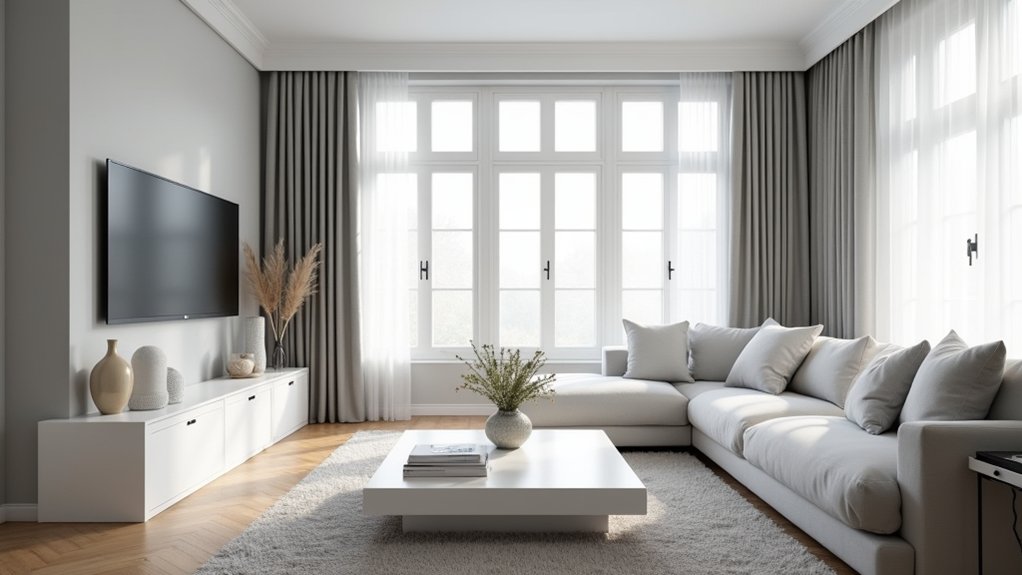
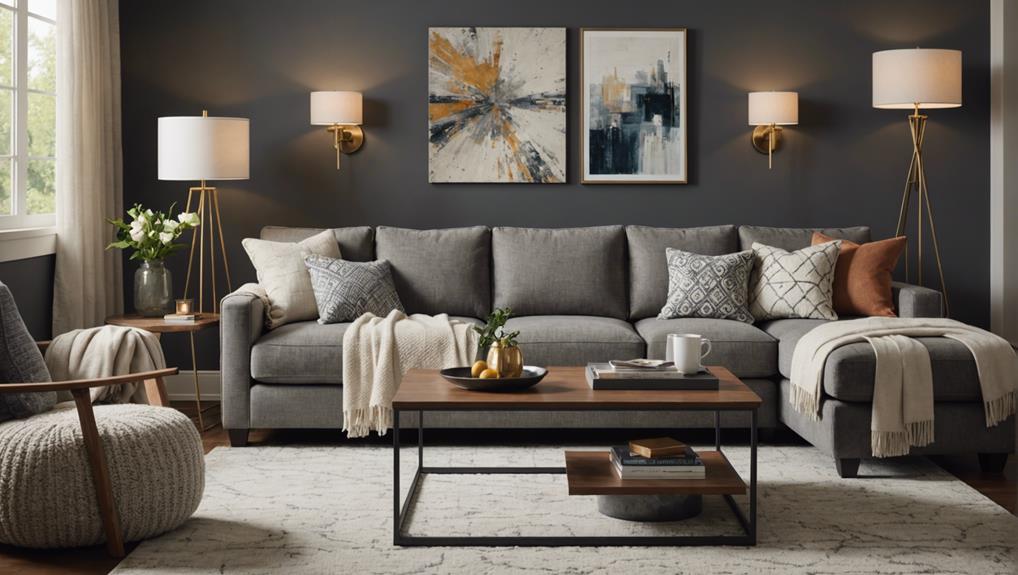
Leave a Reply